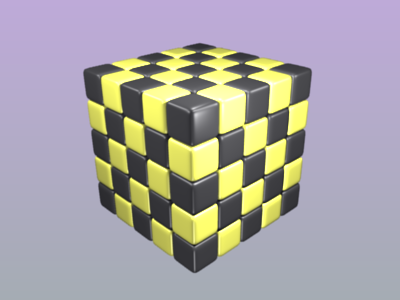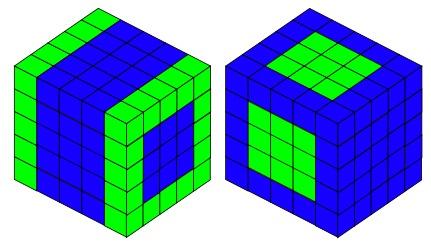Drilling many cubes
A useful visualising exercise which offers opportunities for discussion and generalising, and which could be used for thinking about the formulae needed for generating the results on a spreadsheet.
Problem
More graphic introductions to this activity can be found in Start Cube Drilling and Cube Drilling
Alternatively we can go straight on:
FIRST
Imagine a 4 by 4 by 4 cube hanging in front of you with just the front face facing you. The cube is made up of 4 x 4 x 4, 64 cubes.
You drill holes through the four corner cubes, that are facing you, all the way through to the back.
A friend looks down on the cube, from above, and they also drill four holes through their four corner cubes all the way through to the bottom.
You and your friend examine all the 64 small cubes.
You need to find out how many small cubes have holes in them and how many have no holes in them.
Please justify your findings to someone else!
Then look at how many small cubes have two holes and how many just one hole?
SECOND
Instead of drilling in the corners, a 2 x 2 square in the middle of the face is chosen and these are drilled through to the back. The person looking from above also chooses the middle part of the face and drills through these to the bottom.
You and your friend examine all the 64 small cubes. You need to find out how many small cubes have holes in them and how many have no holes in them.
Please justify your findings to someone else!
Then look at how many small cubes have two holes and how many just one hole?
THIRD
Now suppose the same things happen but this time the cube is a 5 x 5 x 5 cube:
The first part will be similar but for the second part you chose to drill through the square that's just inside the edge, and drill through all the small cubes that make up that square. (See Hint if this is not clear)
Again the challenge is to work out how many small cubes have holes and how many do not have holes.
Then look at how many small cubes have two holes and how many have just one hole?
FOURTH
Go further with larger and larger cubes and examine relationships and patterns, both
- between the two different kinds
of drilling
- and between different sizes of cubes.
- and between different sizes of cubes.
FIFTH
Why stick to corner drilling and central square
drilling?
Consider large cubes made up of black and yellow cubes in a
chess board type pattern.
Then explore as before.
Then explore as before.
Image

Getting Started
Here we see the two kinds of drilling with the green cubes showing those that have been drilled through.
Image

Teachers' Resources
If you've decided to go onto some written work in the form of a spreadsheet there are plenty of opportunities for thinking hard about the formulae that are required to generate further results.
These formula will often come from firstly visualising, comparing with others how they have visualised, then, trying to jot down ideas either pictorially or numerically.
The activity could then be extended into looking at the results achieved for a number of sizes of cubes, and asking about the patterns that are evident.
As is often the case, by looking at Digital Roots in many instances further patterning can beobserved.
With any patterns that are noticed it is always good to ask WHY such patterns have come about. This can sometimes lead the person to exclaim "Of course !!!"
